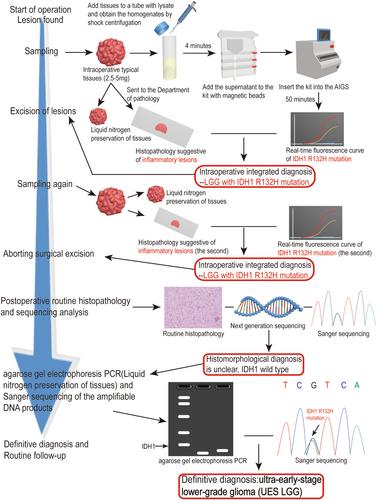Ultra-early stage lower-grade gliomas: How can we define and differentiate these easily misdiagnosed gliomas through intraoperative molecular diagnosis
Abstract
Background
Some lower-grade gliomas (LGG) are difficult to distinguish morphologically from glial cell proliferation or inflammatory changes during surgery, leading to a high risk of incorrect diagnosis. It is crucial to differentiate between the two for making surgical decisions. We define these critical cases as “ultra early stage lower-grade gliomas (UES-LGG)”.
Methods
We analyzed 11 out of 13 cases diagnosed with “gliosis” or “inflammatory changes” during surgery who tested positive for isocitrate dehydrogenase (IDH). Additionally, we conducted qRT-PCR detection on 35 samples diagnosed with LGG during surgery and analyzed their DNA content within an effective circulating threshold range to infer the critical value between UES-LGG and LGG. We conducted experiments using five standardized samples to infer the limited range of accurate detection of UES-LGG during surgery.
Results
In the comparative analysis of 11 samples and 35 samples, it was found that while there was no significant difference in the average DNA detection concentration between the two groups (159.36 ± 83.3 ng/μL and 146.83 ± 122.43 ng/μL), there was a notable statistical variance in the detection threshold for positive mutations (31.78 ± 1.14 and 26.14 ± 2.69, respectively). This suggests that the IDH mutation rate may serve as an indicator for differentiation between the two groups. Subsequently, DNA was extracted from standardized IDH mutant samples and subjected to gradient dilution for detection purposes. The results indicated a consistent increase in detection threshold as detection concentration decreased. When the detection concentration fell below <0.1 ng/μL, it became impossible to carry out effective threshold range detections. To further identify the precise detection interval, we conducted gradient division once again and sought to simulate the functional relationship between DNA copy number and cycle threshold within this interval. The research revealed that when the minimum detection concentration exceeded 250 copies/μL, a 100% detection rate could be achieved.
Conclusions
This article defines UES-LGG as a tumor type easily misdiagnosed in clinical practice due to its extremely low positivity rate during surgery. The popularization of qRT-PCR based intraoperative molecular diagnosis greatly reduces errors caused by manual detection and improves disease detection rates during surgery. It provides a theoretical basis for more accurate surgical plans for surgeons.


 求助内容:
求助内容: 应助结果提醒方式:
应助结果提醒方式:


